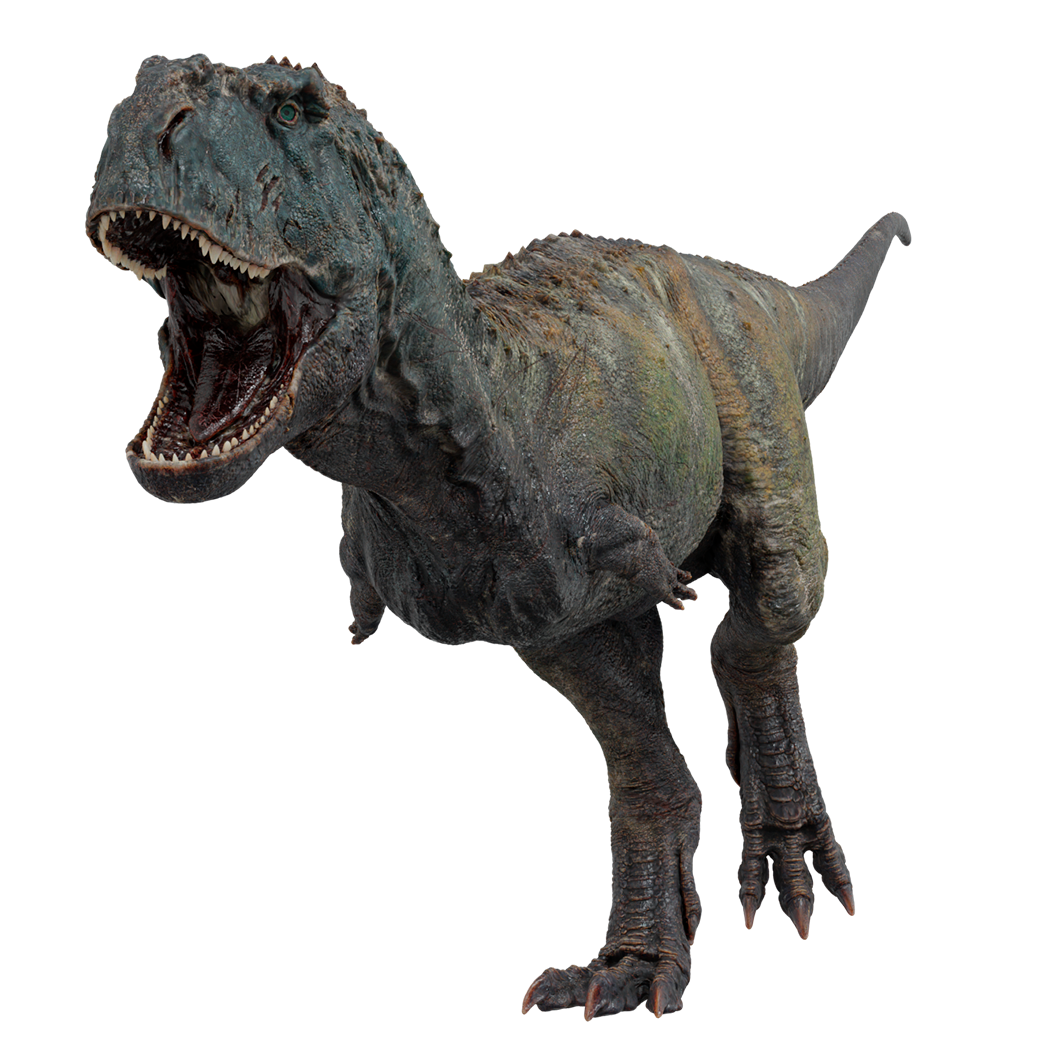The Big-Headed Abelisaur With Even Bigger Competition
Ekrixinatosaurus was once suspected to be the largest abelisaur, though later studies showed that it had a proportionally large head which made it seem larger than it actually was, perhaps giving it a predatory edge in an environment dominated by much larger carnivores.
Overview: Ekrixinatosaurus was described in 2004 after a somewhat explosive discovery, and its proportionally large head led some researchers to hail it as the largest of the abelisaurids. Later studies showed that, while still large for an abelisaur, it was not the biggest, just a bit big-headed compared to the largest abelisaur, Carnotaurus, to which it was being compared. But despite its large size, Ekrixinatosaurus was not the apex predator of mid-Cretaceous Argentina. During the early and mid- Cretaceous, abelisaurs typically played second fiddle to larger carcharodontosaurs, and Ekrixinatosaurus happened to live in the shadow of one of the largest predators of all time, Giganotosaurus.
Discovery: Ekrixinatosaurus novasi was discovered in the Candeleros Formation in Patagonia, Argentina, dating to 100-97 million years ago. It was described and named in 2004 by Jorge Calvo, David Rubilar-Rogers, and Karen Moreno. Its name means “Explosion-Born Lizard” in reference to the holotype being uncovered by dynamite as part of excavations for building a gas pipeline. The species name honors Dr. Fernando Novas, an Argentine paleontologist known for his work on abelisaurs. The holotype and only specimen (MUCPv-294) was well-preserved, and one of the most complete abelisaurs ever discovered.
Evolution and Physical Description: Ekrixinatosaurus was a member of the theropod family Abelisauridae. These animals are part of the clade Ceratosauria and branched off from other theropods early in the Jurassic. Abelisaurs were southern hemisphere theropods and developed a distinctive look of their own. They had proportionally very short and deep skulls, with upward curving jaws that gave them a sort of “smile”. Their skulls were typically decorated with small horns or other rugose ornamentation, and they had extremely short, possibly vestigial, arms that made the arms of tyrannosaurids look long by comparison. In these regards, Ekrixinatosaurus was a fairly typical abelisaur with a proportionally short and deep skull, abelisaur “smile”, tiny arms, and rugose sculpting of the skull surface in the form of small bumps and pits. At 6.5-8 m (21-26 ft) long and weighing 800 kg (1,800 lb), just shy of a ton, it was one of the larger abelisaurs, though not the largest outright. It was thought, based on its large skull (about 83 cm or 32.68 inches in length), which is larger than the skull of Carnotaurus, the largest known abelisaur, that Ekrixinatosaurus was larger, possibly up to 11m (36 ft) in length. However, comparisons with the rest of the skeleton show that Carnotaurus is indeed larger, while Ekrixinatosaurus just had a proportionally larger head.
Ecology: The Candeleros Formation of Argentina which Ekrixinatosaurus called home represents a desert environment with a braided river system running through it. While an overall arid environment, areas around the rivers were much more lush, sometimes swampy, and supported abundant wildlife both large and small. Crocodyliformes, turtles, early snakes, frogs, and small mammals and pterosaurs were among the biodiversity known from Ekrixinatosaurus’s environment. The small unenlagiine dromaeosaur Buitreraptor would have been a likely predator of some of these small animals. Larger herbivores included iguanodonts as well as sauropods including the rebachisaurid Limaysaurus and the titanosaur Andesaurus. Ekrixinatosaurus’s large head and stout robust build suggests that it was a powerful animal capable of dealing great damage to the animals upon which it preyed (likely herbivorous dinosaurs) and to members of its own species in cases of intraspecific combat, perhaps over territory or over mates. However, it would have had to watch its back (or tail) because it was far from the largest predator in the Candeleros Formation. The enormous Giganotosaurus, possibly reaching lengths of over 40 ft and weighing over 7 tons, was one of the largest theropods ever, surpassed in length only by Spinosaurus and surpassed in weight only by T-rex, and was the undisputed apex predator of the Candeleros Formation. Giganotosaurus likely hunted sauropods, but like other large carnivores throughout time, it may have also engaged in kleptoparasitism, or stealing food from other animals. Like a grizzly bear bullying a wolf off its kill, or a lion robbing a cheetah, Giganotosaurus may have occasionally stolen the kills of Ekrixinatosaurus. As tough as Ekrixinatosaurus was, it would have been no match for an adult Giganotosaurus, which weighed over seven times more (though it could have successfully competed with juvenile and subadult Giganotosaurus). So when making a kill, Ekrixinatosaurus likely would have had to eat quickly in case a Giganotosaurus were to show up and steal its dinner. Perhaps this is why Ekrixinatosaurus had a proportionally large skull; bigger jaws can bite off more meat quicker, potentially giving it an edge while living in the shadow of the largest predator to ever inhabit South America.
Extinction and Legacy: What exactly caused the extinction of Ekrixinatosaurus is unknown, but it wasn’t a mass extinction. More likely, it was simply replaced in the never-ending grind of evolution and ecological change. Similar abelisaurs continued on until the end of the Age of Dinosaurs 66 million years ago. Interestingly, they outlasted their competition, as carcharodontosaurids went extinct about 89 million years ago, leaving South America, and much of the rest of the southern hemisphere, to the abelisaurs. After spending upwards of 56 million years in the shadow of the carcharodontosaurids, abelisaurs were second fiddle no longer. The bones of Ekrixinatosaurus are housed in the Universidad Museo de Ciencias Naturales (MUC) Universidad Nacional del Comahue, in Neuquén, Argentina.
Ekrixinatosaurus FAQ
Ekrixinatosaurus size / How big was Ekrixinatosaurus?
See height, weight, and length.
Ekrixinatosaurus height / How tall was Ekrixinatosaurus?
Ekrixinatosaurus was probably around 3 meters (9.8 ft) tall.
Ekrixinatosaurus weight / How much did Ekrixinatosaurus weigh?
Ekrixinatosaurusprobably weighed about 800 kg (1,800 lb).
How long was Ekrixinatosaurus?
Ekrixinatosaurus grew up to 6.5 to 8 m (21 and 26 ft)in length.
What did Ekrixinatosaurus eat?
Ekrixinatosaurus ate meat, specifically other dinosaurs.
What is Ekrixinatosaurus’s closest living relative?
Like all dinosaurs, the closest relatives of Ekrixinatosaurus are the only surviving lineage of dinosaurs today, the birds. Crocodilians, while not dinosaurs themselves, are also more distant cousins of dinosaurs.
Ekrixinatosaurus family members / Ekrixinatosaurus family / What kind of dinosaur was Ekrixinatosaurus?
Ekrixinatosaurus was a theropod (two-legged, mainly carnivorous dinosaurs) in the family Abelisauridae, making it a close relative of the later and more famous Carnotaurus. Abelisaurs were part of the larger clade Ceratosauria which also included Ceratosaurus.
How many teeth did Ekrixinatosaurus have?
Ekrixinatosaurus had around 70 teeth!
Where did Ekrixinatosaurus live? / Where was Ekrixinatosaurus found?
Ekrixinatosaurus lived in what is now Patagonia, Argentina.
When did Ekrixinatosaurus live?
Ekrixinatosaurus lived about 100-97 million years ago at the beginning of the Late Cretaceous Period.
What does Ekrixinatosaurus mean? / Ekrixinatosaurus name meaning
Ekrixinatosaurus means “Explosion-Born Lizard”.

